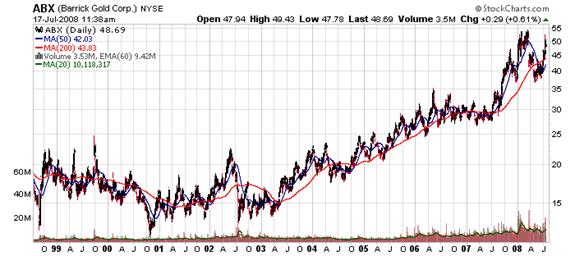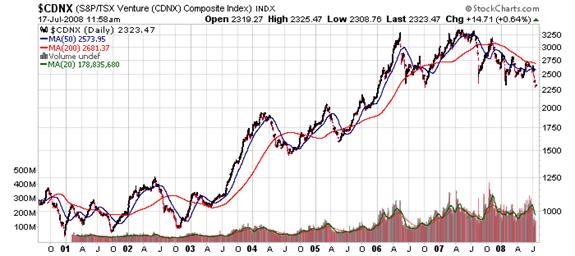Primer in Mining Equity Market Investments
Commodities / Resources Investing Jul 21, 2008 - 01:18 PM GMTBy: John_Lee
 In the past paper, we talked about the vast performance disparity among metals, and offered our take on which metals to buy (Gold, Zinc) and which to avoid (Copper) going forward.
In the past paper, we talked about the vast performance disparity among metals, and offered our take on which metals to buy (Gold, Zinc) and which to avoid (Copper) going forward.
Not all metals are created equal - metals review: http://new.goldmau.com/article.php?id=224 In this paper, we will provide the rationale behind mining equity investment, how to choose between metals futures or metals miners, and conclude with which mining sectors to buy and which to avoid.
Rationale behind mining equity investment:
The key to investing in mining equity is leverage. Suppose a copper miner's break-even point is 70 cents a pound. The company wouldn't have been worth much when copper was 70 cents as it couldn't turn a profit.
At a $1.00 copper price, however, the company will make 30 cents per pound of copper produced. And at $4.00 copper, its earnings will go up eleven times over to $3.30 cash earnings per pound.
Mining vs direct commodity investment
So the theory is that if copper prices go up 4-fold, copper mining stocks would go up 11-fold. In fact, this is pretty much what has happened since 2002. As copper went from 70 cents to $4.00, giant copper miners such as BHP went from $8 to $90.
BHP

If BHP's case were universal to miners, would all investors jump on the mining bandwagon to take advantage of booming commodity prices?
Only if the case is so clear cut; indeed, if we look at Oil and Gold mining equities, a different picture emerges.
Crude went from $22/barrel post-Iraq War to now over $130/barrel, yet Exxon Mobil has merely doubled from $40 to $80.
Exxon Mobil:

Gold went from $250/oz in 2001 to $970/oz today, yet Barrick, world's largest gold miner, has merely tripled from $15 to $45.
Barrick Gold:

So why have gold miners and oil companies underperformed relative to gold and oil respectively? We can only speculate:
- Equities seldom trade at fair value: investing would be easy if all companies were to trade at fair value. The sentiment pendulum swings to from fear to greed.
- Equity investors are different from commodities futures investors. Mining investors seek earnings, while commodity investors are speculating on future prices.
- Gold mining companies have "optionality value", which means their resource of gold in the ground yet to be mined. Such a concept is foreign to many earnings-focused money managers.
- Mining is a risky business: accidents, nationalization, appropriation, labor strikes, tectonic movements and cost overruns are common.
- Rock or Jewel? Metals prices are volatile, and stock valuation is forward looking. What future metal price does an analyst use to forecast the future earnings of a miner?
- Mining is a burning stick: Miners need to constantly develop and acquire new reserves and properties. It is a costly and lengthy process to develop new deposits, which makes a valuation so much tougher to assign.
The point here is that the success of BHP, while not unique, is not the standard throughout the entire mining universe.
Junior Mining Sector in the dog house
If one looks for the speculative extreme in mining equities, the junior mining sector, a dire case could be made against investing in mining. The sector has utterly failed to live up to the expectations of investors. Junior resource equities are supposed to provide greater leverage than major mining producers. However, the nature of the business requires a constant injection of capital to discover and develop deposits before the eventual handsome operating cashflow is realized. This model is vulnerable to sudden and occasional credit/liquidity crunches like the one we're experiencing now.
The Toronto Stock Exchange Ventures Index, which is a proxy to junior stocks, merely doubled from the bottom of 1,000 to trade at 2,300.

Cash is king in uncertain times, and we like cash in gold.
We live in uncertain times. GSE's (Freddie Mac and Fannie Mae) are on life support with the Federal Reserve Bank of New York. All together, GSE's back $5 trillion US of low yield (5%-7%) assets. You have to wonder what the global asset managers holding those debts are going to do.
Real estate is cooling off worldwide now, from Singapore and Thailand to Vancouver. I am not seeing, nor do I think that housing will crash, though. The Asians are running in a mad panic over inflation and yet we have interest rates at 2-3% from Hong Kong to Singapore, Thailand to Japan, Korea to Taiwan. On top of that, we have global equity indices rotting with most down by double-digit percentages, with some, such as Vietnam's down some 70% this year. The point is there's nothing stronger to invest in at the moment than gold. We are now seeing a nice gold run as interest rates begin to trend up.
Conclusion:
This four-page paper is no means exhaustive, I hope however it served as a high-level overview on mining. The Barrick and junior resource camp may be glad to know 10-bagger success does happen to miners, as BHP demonstrated. The BHP camp might take caution in that mining isn't all risk-free glorious business.
We didn't have the foresight to put all our money in BHP, and instead we focused on juniors exploring for gold in exotic locations such as Africa. Being a Feng Shui student, I learn that every dog has its day, and perhaps finally it's time for the past dogs of Barrick and other gold miners to shine?
John Lee, CFA
johnlee@maucapital.com
John Lee is a portfolio manager at Mau Capital Management. He is a CFA charter holder and has degrees in Economics and Engineering from Rice University. He previously studied under Mr. James Turk, a renowned authority on the gold market, and is specialized in investing in junior gold and resource companies. Mr. Lee's articles are frequently cited at major resource websites and a esteemed speaker at several major resource conferences.
John Lee Archive |
© 2005-2022 http://www.MarketOracle.co.uk - The Market Oracle is a FREE Daily Financial Markets Analysis & Forecasting online publication.



